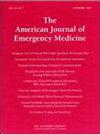肥胖是否能改善社区获得性肺炎患者的预后?来自MIMIC-IV数据库的见解。
IF 2.2
3区 医学
Q1 EMERGENCY MEDICINE
引用次数: 0
摘要
目的:体重指数(BMI)与临床结果呈正相关,被称为“肥胖悖论”。然而,肥胖是否对社区获得性肺炎(CAP)危重患者有保护作用尚不清楚。在此,本研究旨在探讨BMI与危重CAP患者预后的关系。方法:本队列研究分析重症监护医学信息市场(MIMIC)-IV数据库中需要ICU住院的CAP患者。患者分为体重过轻组、正常组、超重组和肥胖组。研究结果包括90天死亡率、脓毒症发展、急性肾损伤(AKI)发生、住院时间(LOS)、ICU住院时间和机械通气。采用多元回归模型和限制性三次样条(RCS)回归分析BMI对研究结果的影响,并对可能的混杂变量进行校正。结果:共有2874名符合条件的患者入组。研究人群的中位年龄为67.0岁,男性占多数(54.9%)。体重过轻组的死亡率最高,而肥胖组的死亡率最低。肥胖与ICU住院时间延长、通气时间延长和AKI风险增加显著相关。RCS分析进一步证实BMI与90天死亡率呈l型关系,BMI在33-35 kg/m2范围内死亡风险最低。增加BMI的增量效益在34 kg/m2时趋于稳定。结论:在CAP危重患者中发现了肥胖与死亡率之间的关系。值得注意的是,我们的研究独特地揭示了BMI与90天死亡率之间的关系是非线性的,并且在BMI超过34 kg/m2的个体中,BMI水平的增加没有额外的降低死亡率的益处。本文章由计算机程序翻译,如有差异,请以英文原文为准。
Does obesity improve the prognosis of patients with community-acquired pneumonia? Insights from the MIMIC-IV database
Objective
Positive associations between body mass index (BMI) and clinical outcomes have been found and are called “obesity paradox”. However, whether obesity has protective effects on critically ill patients with community-acquired pneumonia (CAP) remains unclear. Herein, this study aims to investigate the association of BMI with outcomes in critically ill patients with CAP.
Methods
This cohort study analyzed patients with CAP requiring ICU admission from the Medical Information Mart for Intensive Care (MIMIC)-IV database. Patients were categorized as underweight, normal weight, overweight and obese group. Study outcomes included 90-day mortality, sepsis development, acute kidney injury (AKI) occurrence, length of hospital stay (LOS), length of ICU stay and mechanical ventilation. Multivariate regression models and restricted cubic spline (RCS) regression were performed to analyze the impact of BMI on study outcomes adjusting for possible confounding variables.
Results
A total of 2874 eligible patients were enrolled in this study. The study population had a median age of 67.0 years with a male predominance (54.9 %). The underweight group had the highest mortality rate, while the obese group exhibited lowest rates. Obese was significantly associated with a longer length of ICU stay, duration of ventilation, and an increased risk of AKI. RCS analysis further confirmed a L-shaped relationship between BMI and 90-day mortality, with the lowest mortality risk observed at a BMI range of 33–35 kg/m2. The incremental benefit of increasing BMI plateaued at 34 kg/m2.
Conclusions
A relationship between obesity and mortality was identified in critically ill patients wi1th CAP. Notably, our study uniquely reveals that the relationship between BMI and 90-day mortality is non-linear, and there is no additional mortality-reducing benefit associated with increasing BMI levels among individuals with a BMI exceeding 34 kg/m2.
求助全文
通过发布文献求助,成功后即可免费获取论文全文。
去求助
来源期刊
CiteScore
6.00
自引率
5.60%
发文量
730
审稿时长
42 days
期刊介绍:
A distinctive blend of practicality and scholarliness makes the American Journal of Emergency Medicine a key source for information on emergency medical care. Covering all activities concerned with emergency medicine, it is the journal to turn to for information to help increase the ability to understand, recognize and treat emergency conditions. Issues contain clinical articles, case reports, review articles, editorials, international notes, book reviews and more.

 求助内容:
求助内容: 应助结果提醒方式:
应助结果提醒方式:


